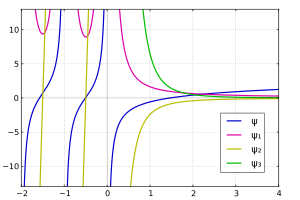
visualized using domain coloring

In mathematics, the digamma function is defined as the logarithmic derivative of the gamma function:[1][2][3]
It is the first of the polygamma functions. This function is strictly increasing and strictly concave on ,[4] and it asymptotically behaves as[5]
for complex numbers with large modulus () in the sector with some infinitesimally small positive constant .
The digamma function is often denoted as or Ϝ[6] (the uppercase form of the archaic Greek consonant digamma meaning double-gamma).
- ^ Cite error: The named reference
AbramowitzStegunwas invoked but never defined (see the help page). - ^ Cite error: The named reference
DLMF5was invoked but never defined (see the help page). - ^ Cite error: The named reference
Weisssteinwas invoked but never defined (see the help page). - ^ Alzer, Horst; Jameson, Graham (2017). "A harmonic mean inequality for the digamma function and related results" (PDF). Rendiconti del Seminario Matematico della Università di Padova. 137: 203–209. doi:10.4171/RSMUP/137-10.
- ^ "NIST. Digital Library of Mathematical Functions (DLMF), 5.11".
- ^ Pairman, Eleanor (1919). Tables of the Digamma and Trigamma Functions. Cambridge University Press. p. 5.







